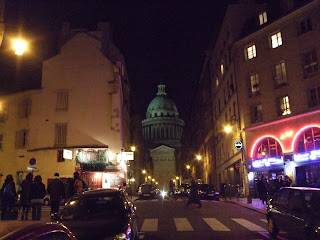
Walking along one of the quais on the Ile St-Louis in the early afternoon I noticed signs pointing to the Institute de Monde Arabe just across the bridge. I decided to have a closer look. The building itself is worth seeing with its facade of mostly intricate glass and is truly dazzling in sunlight. Designed by architect Jean Nouvel, who has several other notable nameplates around town, it is quite something to behold. The Institute is really a museum, one with a strong educational component and it is said to have quite a good permanent collection of art and all sorts of materials which are intended to cast a positive light on the complex world of the Arabs. Its special exhibitions, though, draw the crowds. Currently filling the walls from dawn to dusk is “Bonaparte in Egypt”, which explores a pretty interesting chapter in Napoleon’s checkered resume. Just at the end of the 18th century Napoleon, then a general in the French Army, went off to Egypt to have a look, taking thousands of French soldiers along for the ride. It was not altogether a successful venture but the French made their mark, claimed title to various properties, did some serious research, and fought a few battles. Won some. Lost some. Then Napoleon left (he went home and declared himself Emperor) and left many of his troops behind. It took about 150 years for the French finally to work their way entirely free from this entanglement. This exhibit was more educational than entertaining, but it was new ground for me to plow, and worth the visit.
Earlier I had picked up some shirts which I had left to be pressed at the neighborhood cleaners and the charge for this service has made me think it might be best in the future to buy new shirts rather than getting my old wrinkles ironed out. It cost twenty euros, or about $27—that is $9 apiece— to have three shirts finished. Wow.
Easily the high point of today was tonight. As someone with a real passion for chamber music, it is a serious treat to be invited to hear classical music performed in a—chamber. Such was my good fortune tonight. Nancy Machiah, a dear person whose company I have come to particularly enjoy while In Paris, is a very big supporter of the arts, especially musical arts. Just up the way from the Arc de Triomphe, which at twilight is pretty awesome,
 her very large and marvelous apartment on Rue Mac Mahon is alive with music. Nancy sings with the Paris Choral Society, both of her children have studied music and she is generous in providing her spacious quarters for music classes, rehearsals and so forth. Tonight she arranged a concert for friends. Playing were Nitzan Laster, a cellist with the Netherlands Philharmonic, which plays its regular season at the Concertgebouw, and Shahar Rosenthal, a violinist who studied at Interlochen in Michigan in high school, then matriculated to Indiana University and studied with Joseph Gingold.
her very large and marvelous apartment on Rue Mac Mahon is alive with music. Nancy sings with the Paris Choral Society, both of her children have studied music and she is generous in providing her spacious quarters for music classes, rehearsals and so forth. Tonight she arranged a concert for friends. Playing were Nitzan Laster, a cellist with the Netherlands Philharmonic, which plays its regular season at the Concertgebouw, and Shahar Rosenthal, a violinist who studied at Interlochen in Michigan in high school, then matriculated to Indiana University and studied with Joseph Gingold.  Among his stops was a stay with the Owensboro Kentucky Symphony! When was the last time you chatted with a former member of that ensemble? By the way, Nitzan was headed back to Amsterdam and naturally we made plans to meet there in the next few weeks if, as I hope, I can get back to one of my favorite cities.
Among his stops was a stay with the Owensboro Kentucky Symphony! When was the last time you chatted with a former member of that ensemble? By the way, Nitzan was headed back to Amsterdam and naturally we made plans to meet there in the next few weeks if, as I hope, I can get back to one of my favorite cities.About 40 guests mingled while sipping champagne before the lights dimmed for the first piece, a six-movement suite for solo cello (no. 3, BWV 1009) by Bach, energetically performed by Nitzan. This was followed by a duet written by the Czech composer Bohuslav Martinu and the atonality of this piece was quite a jolting change. After intermission the pair played the Hungarian Zoltan Kodaly’s Duo for Violin and Cello, op 7, and they did it beautifully to great applause as this is a piece which provides plenty of moments for virtuosity. They were persuaded to play an encore and it was delicious: a passacaglia by Handel.
It was such a good experience to hear this kind of music in an environment for which it is written yet rarely performed. Quite special. Afterwards a group of us including Nancy (pictured with Shahar on her right and Nitzan),


had a rollicking time at a noisy Italian restaurant. Nitzan couldn’t make it but Shahar and his mother, who had come from Israel for the affair, joined us. It was saltimbocca for me. Shahar will soon return to Madrid where he is a member of the National Orchestra of Spain. My other new Nancy friend, Nancy Brune, offered to drive me all the way home, an extraordinarily gracious gesture which concluded a terrific day.














































